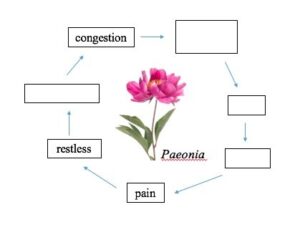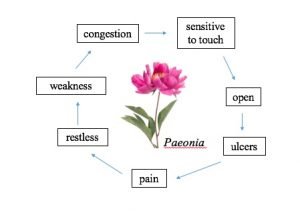Using Cycles and Segments to Practice Homeopathy More Effectively: Hemorrhoids in a Paeonia Case
Tolle Totum
Tiffany Bloomingdale, ND
There are a variety of ways that our elegant naturopathic modality, homeopathy, is practiced. The general framework of remedy selection typically includes case taking, analysis with repertorization and consulting a materia medica to differentiate the front-runners. Over time, through learning homeopathy in the classroom and using it clinically with patients, we develop a sense of the essence of many of the polycrest remedies. For example, for sepia, “Vithoulkas has given as the central theme of the remedy ‘stasis’ or a state brought about by neutralization of the dynamic tensions which animate all organisms.”1 Many naturopathic doctors using homeopathy will see sepia in a chilly woman with a bearing-down sensation in the pelvic region and marked irritability towards her loved ones. Understanding remedies intimately can lead us to shift away from the structured process of getting to the similimum, toward relying more heavily upon how we feel about the case in front of us.
Naturopathic medicine is a quintessential healing art in that philosophy and intuition, alongside knowledge and evidence-based medicine, when available, all inform the practitioner’s decision making. With homeopathy, if we give an incorrect remedy, there may be a temporary, minor aggravation or there will not be a notable change. However, if we give the correct remedy, symptoms will shift and patients will move in the direction of health. Are there limitations to the effectiveness of our prescribing in homeopathy if we often depend on feeling or sensing a remedy state? If the patient in front of us is presenting a remedy that we do not know, we will miss it. What if we fall back on the traditional method of repertorization and materia medica review—are we then more unlikely to miss a remedy? That depends upon whether or not we have represented the case in its entirety by our rubric selection.
Cycles and Segments
The Cycles and Segments approach to practicing homeopathy, as taught by seasoned naturopathic physicians Paul Herscu and Amy Rothenberg at the New England School of Homeopathy, offers a holistic lens through which to take and analyze cases. Ultimately, Cycles and Segments allows us to connect with remedies we may not know and ensures that we encapsulate the totality of our patient’s presentation.
Cycles and Segments involves looking for themes (the segments) in a case and then organizing them sequentially based upon the patient’s experience of them (building the cycle). The cycle moves in one direction and creating it involves identifying what comes before and what happens after each segment. Essentially, applying the Cycles and Segments philosophy to a case allows us to get clear about our patient’s particular story.
If we can gather several examples of a theme, and ideally find symptoms from the physical and mental or emotional realms, then we may identify it as a segment. Typically, we can readily identify four to six segments in a case. When analyzing the case, we want to be sure that all of the well-established segments are represented in our rubric selections. Without Cycles and Segments, we may repertorize a list of symptoms that are actually all examples of just one segment. We can use a materia medica to construct cycles for each remedy, as well as reference Cycles and Segments literature.2,3 In the spirit of like-treats-like, the cycle of the similimum will align with the cycle of the patient.
Using Cycle and Segments with Paeonia
Let me illustrate some of these points about using Cycles and Segments with a lesser-known remedy, paeonia, as an example, looking at how we may come to use it for a case of hemorrhoids. If we go to paeonia in Concordant Materia Medica4 and begin reading about it, we will see ideas repeated.
For example:
“Rolls on floor from pain…”
“Pain [of fissue ani] compelling the sick to walk the floor all night.”
“… continues long after stools; must rise and walk about.”
“Restless sleep, disturbed the first night by by burning…”
What is common about these excerpts is that they are all describing a restlessness or need to move because of excruciating pain.
We can also see a series of ways in which pain shows up for paeonia:
“Burning in anus after stool…”
“Painful ulcer…”
“Shooting or splinter-like pains.”
“… burning, itching and swelling of anus.”
“External genitals… painful.”
A third theme that is readily observable is associated with swelling and congestion:
“… many symptoms of congestion – rush of blood to head, face, chest…”
“Pressure in pit…”
“… itching in anus; orifice swollen.”
“External genitals swollen…”
So far, we have a clue about the order of events: movement from pain. At this point, a rough sketch of paeonia’s cycle and segments may look like this:

If we continued in this fashion, the complete cycle of paeonia, as described by Dr. Paul Herscu at the New England School of Homeopathy 10-Weekend Course in October of 2016, emerges:
The Paeonia Case Emerges
The patient with hemorrhoids who needs paeonia would be driven to us by their intense pain. It would have them feeling extremely restless with a compulsion to move, in agony. This would drive them to weakness in body and mind. From this place, their congestion would arise, with heightened sensitivity to any touch. In the patient with hemorrhoids, passing bowel movements would be a source of pain due to physical contact with highly sensitive congested tissue. On the mental and emotional planes, we could expect to see a very expressive patient, with exaggerated emotions paralleling their exaggerated physical sensitivity. After this, the cycle moves into a segment in which the hemorrhoid undergoes opening and ulceration, resulting in a return to the segment of debilitating pain.
Utilizing the Cycles and Segments approach to homeopathic case taking and analysis offers us a way to enrich our understanding of cases and remedies, and help us to be more effective homeopathic practitioners.
References:
- Morrison R. Desktop Guide to Keynotes and Confirmatory Symptoms. Grass Valley, CA: Hahnemann Clinic Publishing; 1993.
- Herscu P. The Homeopathic Treatment of Children: Pediatric Constitutional Types. Berkley, CA: North Atlantic Books; 1991.
- Herscu P. Stramonium With an Introduction to Analysis using Cycles and Segments. Amherst, MA: The New England School of Homeopathy Press; 1996.
- Vermeulen, F. Concordant Materia Medica. Haarlem, The Netherlands: Emryss by Publishes; 2000.
 Tiffany Bloomingdale, ND is a 2013 graduate from NUNM (formerly NCNM) in Portland, OR. While in school, she studied homeopathy extensively with Dr. Will Taylor, Dr. Durr Elmore and Dr. Lysanji Edson. She is currently enrolled in the 2016-2018 New England School of Homeopathy’s 10-Weekend Course in Amherst, MA. She is in private practice at Richmond Natural Medicine in Richmond, VA. Dr. Bloomingdale specializes in constitutional homeopathy. Her practice focuses on functional gastrointestinal concerns, inflammatory bowel disease, women’s and children’s health and offering naturopathic cancer support. http://richmondnaturalmed.com/
Tiffany Bloomingdale, ND is a 2013 graduate from NUNM (formerly NCNM) in Portland, OR. While in school, she studied homeopathy extensively with Dr. Will Taylor, Dr. Durr Elmore and Dr. Lysanji Edson. She is currently enrolled in the 2016-2018 New England School of Homeopathy’s 10-Weekend Course in Amherst, MA. She is in private practice at Richmond Natural Medicine in Richmond, VA. Dr. Bloomingdale specializes in constitutional homeopathy. Her practice focuses on functional gastrointestinal concerns, inflammatory bowel disease, women’s and children’s health and offering naturopathic cancer support. http://richmondnaturalmed.com/










